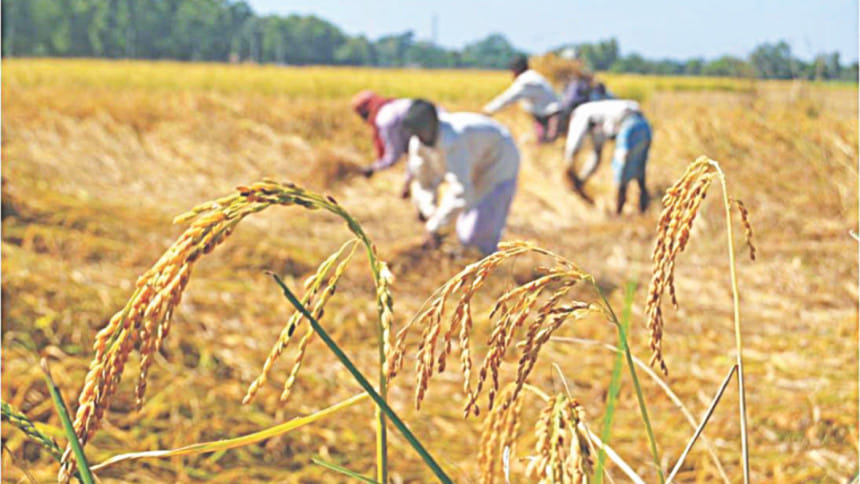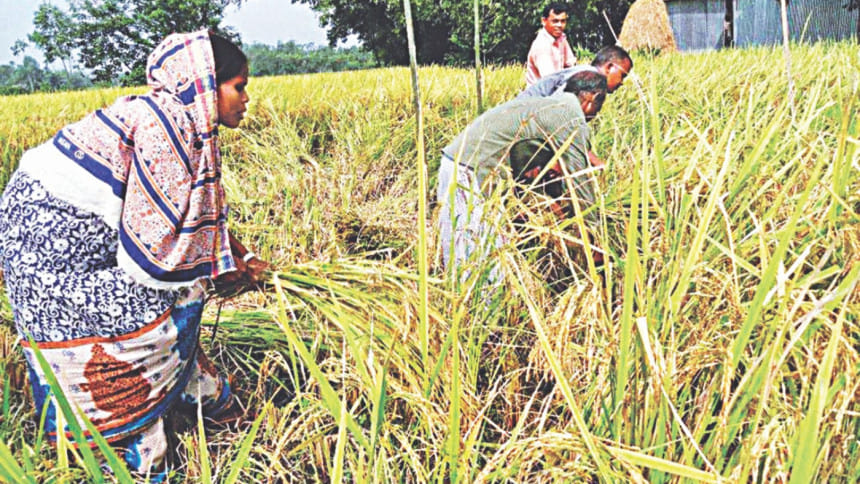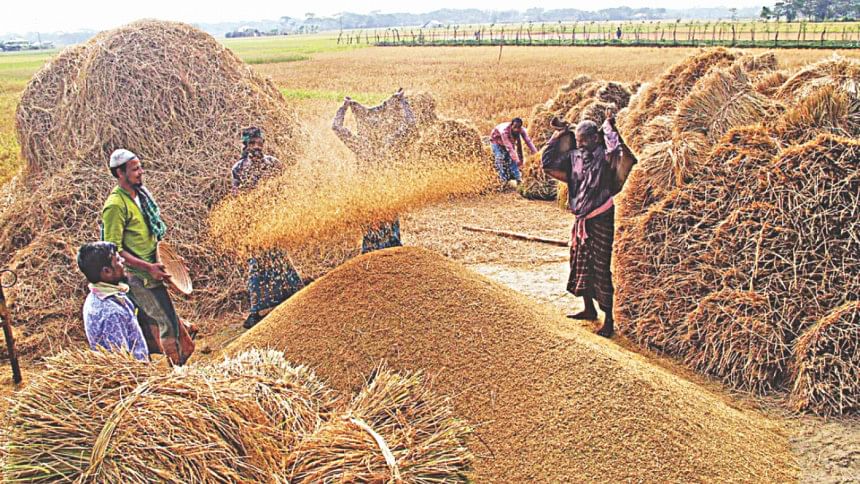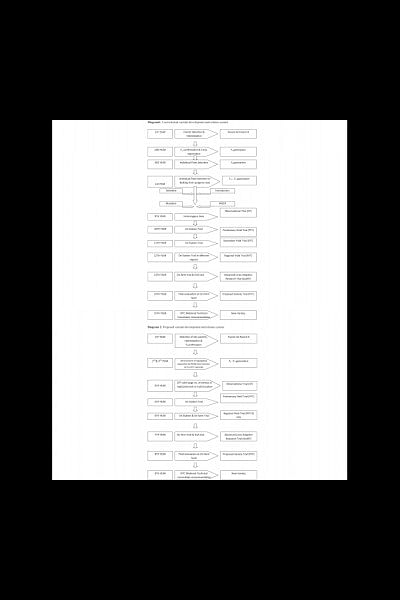Transforming rice breeding

Rice is more than just a food source to us. It is part of our culture, an article of trade to reduce hunger, alleviate poverty and maintain political stability in Bangladesh. Rice covers most of our land almost thorough out the year. We get the lion's share of our daily calorie intake from rice.
The country has a satisfactory upward trend in rice production over the decades. However, with the scientific ingenuity and farmers toil, a farmer's friendly political intervention after 2009 helped the country to attain the ability to export modest amount rice. Even the government included a considerable amount of rice in the relief materials to Nepal after the devastating tremor last year. Therefore, undoubtedly the country has attained self sufficiency in rice, a milestone towards food security, but still away to some extent from the adequacy and accessibility of safe and nutritious food to everybody in the country through peoples' affordability—in other words, sustainable food security.
To achieve sustainability in food security is pretty difficult but not impossible. The highest population density, decreasing per capita arable land, over exploitation of underground water, climate change, lack of adequate number of farmers' friendly crop variety etc. are the prime challenges to achieve the sustainability. Out of those challenges, population growth and grow more food are the prime concern to the government since 1960s. Over the years (1950 to 1965), the population of Bangladesh has increased at the rate of 2.23 million per year. Vis-a-vis rice production has increased over the same time at the rate of 0.03 million tons per year. Despite a lot of measurements, the rate of population is still in its upward trend and would reach around 233 million by 2050. By this time the rice demand for Bangladesh would be around 40 million tons. These trends of rice production and population growth might yield severe shock of food shortage by 2050, provided no significant technology is discovered. It is estimated that shortage of rice at years 2020, 2030 and 2040 will be 1.68, 6.02, and 7.80, million tons, respectively. Similarly, the expected shortage by 2050 would be 10.50 million tons. This prediction is a matter of anxiety to us and the estimation is based on the per capita per day consumption of 541 gm of rice. But we have another estimation where per capita rice consumption is considered 470.49 gm per day (World rice statistics: IRRI). According to this estimation there will be no shortage of rice up to 2030. However, the country might experience the shortage of 2.18 million ton in 2040 (just a year ahead of vision 2041, the year when the country would be a developed one) and 5.69 million ton in 2050. It is good to know that rice consumption in Bangladesh is in decreasing trend and if it comes down around 400 gm per person per day, then rice scarcity might not be a problem even up to the middle of this century. Still we cannot avoid the inevitability of rice from our own source. Therefore, we have to grow rice with our own limited resources along the increasing climatic threats. It means our rice agriculture will be always in tension how to maintain the productivity. Therefore it is a critical problem to take care of.

Total cultivable land (11.37 million ha) under rice has experienced a little change since independence. Transplanted Aman area (5.2 million ha) experienced the same. But the area under Boro has increased a several fold (from 0.5 million ha to around 4.85 million ha) just at the expense of Aus, Jute and some upland crop lands. Therefore, a little scope is left to increase the area under rice with the ongoing cultivars. However, some of the unfavourable land could be exploited if climate smart varieties or technologies are made available. Unfortunately, due to geographical position, Bangladesh is one of the most vulnerable countries in the world with so many extreme events like cyclones, droughts, floods, salinity intrusion, heat and cold waves, etc. Climate change is a reality now. So these extreme events are quite frequent to incur a heavy loss to the crop. Nevertheless, Climate smart varieties and technologies are coming up to cope with the arrogant environment. Though these varieties and technologies might be good for today but not for tomorrow. The alarming situation is that the modern rice varieties have reached their yield plateau. The input use is already high and shrinking the scope of using land and water resources. Even due to some unavoidable reasons, farmers are getting unable to harvest the maximum potentiality of their crops. So the genetic gain (the increase in crop performance that is achieved through genetic improvement programs per unit time of breeding) we are having is not up to mark (0.5%).

Modern rice varieties (MV) in Bangladesh occupies 82% of the total rice area. Despite having a good number (77; originally it was 65; recently 12 new varieties were added in this row) of modern rice varieties only a few (BRRI dhan28 and BRRI dhan29 in Boro and BR11 in Transplanted Aman) has got the status of mega (very popular) varieties. Bangladesh Rice Research Institute (BRRI) released these varieties quite a long time ago (BR11 is released in 1980 (coverage 40% of the T. Aman area) and BRRI dhan28 and BRRI dhan29 in 1994), still they are popular (coverage 60% of the Boro rice) because of their acceptability to the farmer and consumer as well. The present yield potentialities of these varieties are not beyond question. Because they are getting weaker with days to fight against the recently developed biotic and abiotic stresses. Still farmers bother a little to the advice of the scientists to replace these outdated varieties with the new ones. It means Plant Breeders are in difficulties to replace varieties already in farmers' hand. The popular varieties cultivated over the years are in a process of creating unwanted pest-pressures in a cropping system to reduce the total system of productivity. However, this statement might not be true in case of some recently developed stress tolerant varieties. But farmers might encounter the similar problem as we have noticed in the so called mega varieties when the varieties will get old. Therefore, for a particular ecosystem, despite its popularity a conventional variety should be replaced with a new one with desirable trait(s) in every five to seven years or so.

The challenges are many. To overcome few of them we need an efficient breeding pipe line to have readymade supply of variety in need in time. The present variety development procedure (pedigree method) is quite lengthy. It takes 14 to 15 years from breeder's lab to farmer's hand (Diagram-1)
That is why BRRI has decided to reorganise its breeding program through a project (Transforming rice breeding through capacity enhancement of BRRI) adopting new breeding technology and research management methods improving the selection efficiency for the varieties targeting for desirable agronomic traits, biotic and abiotic stresses resistances, grain quality and consumer preferences. Gary Atlin, Scientist and Senior Program Officer from Bill & Melinda Gates Foundation is the main strength behind this work force. In fact, it is a part of the charity intervention of the Foundation as some other projects in action like STRSA (Stress-tolerant Rice for Africa and South Asia) intended to develop drought and saline tolerant rice varieties. Anyway, this project is exclusively for Bangladesh and the technical assistance from International Rice Research Institute (IRRI). Thus, the farmer and consumer oriented variety could be developed and released regularly. In IRRI Dr. Eero Nisslä, head Plant Breeding Genetics and Biotechnology Division and his team is already in progress to change some of their breeding approaches. Scientists are in a process to transform the conventional breeding concept in a business format. They have termed the entire rice breeding system as rice breeding factory and trying reduce variety release time. A study (done at IRRI in 1999) says that reducing a breeding cycle by 2 years has an economic benefit of about USD 18 million over the useful life of a variety. Following the new approach, scientists are optimistic to reduce the breeding pipeline by at least six years to incur a huge economic benefit (Diagram 2).
The new approach of rice breeding at BRRI would adopt the same as in IRRI like modern market research approaches, breeding tools, information management systems, and research team organisation and accountability. To develop location specific varieties reflecting consumer, producer and other value chain actors' preferences, market segments and target environments will be precisely characterised.
Rapid Generation Advance (RGA), a method to make selection method faster from the advance generations of segregating populations under controlled environment will be followed. A technique of single seed descent in this method would allow 3 (generally one generation a year in the existing system) generations a year is the main driving force to reduce the breeding cycle in a variety development system.
The overall transforming breeding procedure will follow the steps as:
* Using low-cost, high-throughput marker-assisted selection (MAS) to quickly and cheaply select for key traits like salinity tolerance, drought etc.
* Increasing breeding program size through digitalisation of data collection and mechanisation of some field operations.
* Increasing selection pressure for yield by introducing multi-environmental yield testing in early generations;
* Improving selection accuracy by introducing an integrating breeding information management system (BIMS).
The objective of the transforming breeding system is to increase the probability of selecting desirable breeding lines. Accordingly, a huge number of fixed breeding lines are to be developed and tested for the desirable traits. Key parents and ancestral lines have to undergo genotyped at high density using genotyping by sequencing (GBS). Before yield testing, lines from RGA will be tested for phenology, quality and resistance traits. MAS will be used using SNP (Single Nucleotide Polymorphism) marker for key traits like quality, stress and disease tolerance. Observational Yield Trial (OYT) will be conducted across the locations. The number of lines under this initial yield trial would be 40-fold (3000) compared to that of the current pedigree method (75). This is because to increase the selection pressure for the key trait to enhance the genetic gain for yield.
A hand-held automatic data recording device will be used to collect the data through barcodes fixed in the field and directly transfer to the computer in the laboratory. Then and there data will be managed and analysed by BIMS. All of the operations will be done automatically to increase the efficiency of the breeding methods. Skilled institutional staff and their liability to the work is an important issue too to execute the task.
The philosophy of the transforming breeding approaches comes from the modern commercial plant breeding practices followed by several famous multinational seed companies. So the rice is considered (already mentioned at the beginning of the article) as an “article of trade” in this breeding approach and designated as focused product profile developed through a chain of machines like “rapid breeding cycle”, high output phenotyping, routine use of molecular markers and wide-scale multi-environmental yield testing. We are expecting BRRI to be proactive in developing the ideal product i.e. farmers' friendly varieties and disseminate them through public-private partnership approach. BRRI has just stepped into the system with the assistance of charitable organisation Bill and Milinda Gates foundation. The output of this project will be as follows:
* 2000 germplasm and breeding lines will be screened against salinity
* 1200 germplasm and breeding lines will be screened against cold and drought, separately.
* 900 germplasm and breeding lines will be screened at the vegetative stage against submergence and water stagnation tolerance.
* 42,000 breeding lines will be screened against major diseases.
* 10600 breeding lines will be analysed for grain quality and nutrition.
* Genotyping by sequencing of 500 parents to be used in breeding program will be done.
* Genome sequencing of 40 BRRI developed varieties
Finally, a huge stock of 40,000 advance breeding lines will be in hand to have a variety in need. Thus, BRRI can confidently ensure that the nation attains sustainable food security in the near future.
The writer is Director General, Bangladesh Rice Research Institute. He can be reached at [email protected]

 For all latest news, follow The Daily Star's Google News channel.
For all latest news, follow The Daily Star's Google News channel. 



Comments